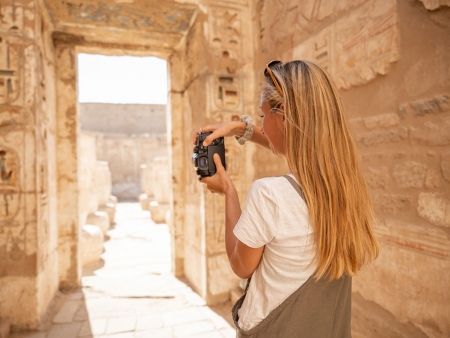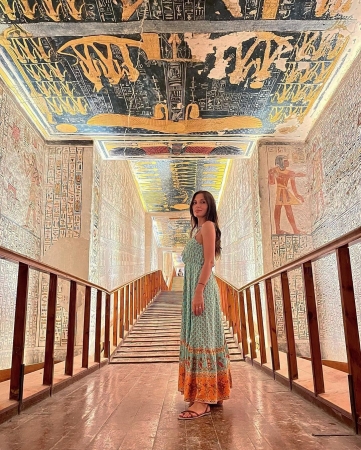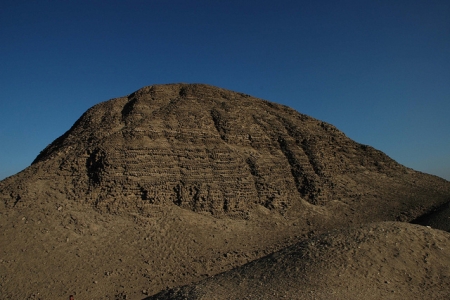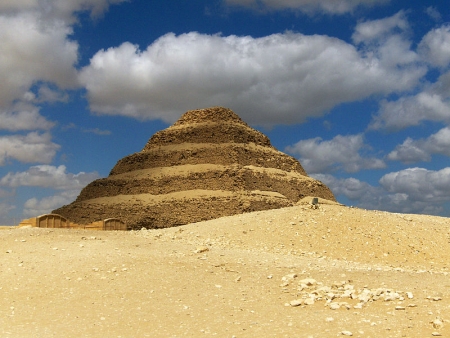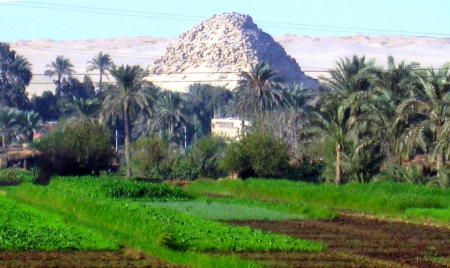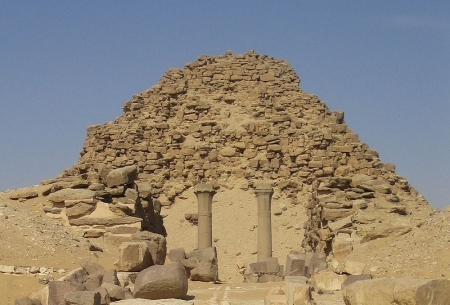Old Kingdom Pyramids | Ancient Egypt

Archaeologists have made many valuable discoveries in this area. We have the Saqqara complex, located 1.6 km inward from the escarpment where wooden bas-reliefs were found in the offering room of the mastaba of the high functionary Hesire. On the east wall, 11 false doors were found. The most amazing discovery was that of the statue of the pharaoh himself. He is shown to be perfect - almost godly - where the carver is able to demonstrate Djoser’s superhuman powers. The king is adorned in the ceremonial Jubilee cloak, his hands are crossed over his chest which is the position showing eternal life. His face is very detailed – high cheekbones, extruding lips, moustache, ritual beard and eyes which were inlaid. Even his subjects were made to look perfect. He is also wearing the wig which is covered in the nemes (headdress). Present on the base of the statue we can see an inscription which states that he was King of Upper and Lower Egypt. There we also find the hieroglyphic signs for the cobra goddess Uadjet (a symbol of Lower Egypt) and the vulture goddess Nekhbet (symbolising Upper Egypt). There is also one of the names of Djoser, Netjerkhet – “His body is divine”. His statue is found in the serdab, a room next to the temple.
Also built during the 3rd dynasty was the Maydum pyramid and in the 4th dynasty, the Dahshur pyramid. These two pyramids were constructed in similar pyramid designs as seen in the Giza Pyramids. These pyramids were built by king Snefru, the father of Khufu.
In the Maydum necropolis, we find the mastaba of Prince Rahotep and his wife. It is here we find wonderful examples of Ancient Egyptian art dating from the 3rd to 4th dynasty. Two very beautiful statues were found showing Rahotep and Nofret seated on white chairs decorated in black hieroglyphics. The two pairs of eyes were inlaid with quartz and alabaster. Rahotep is muscular, has short hair and is painted brown. He is wearing a white loincloth and has a choker around his neck with a heart pendent. Nofret is wearing a white shawl and is painted in a pale brown colour. She is wearing a wig and a very colourful diadem.
We now move to the Giza region when we find the incredible Giza Pyramids that were constructed by one of Egypt’s most powerful families - father, son and grandson. We have the Pyramid of Cheops/Khufu, which is the largest of the three and was the first built. The Pyramid of Chephren/Khafre is the second of the three and the only pyramid of the three that still has the original limestone coating on its tip. The last and the smallest of the three is the Pyramid of Mycerinus/Menkaure. These pyramids focussed on the pharaoh’s divinity and cult. They were built to represent sun rays lifting the pharaoh to unite with the sun god Ra.
Again we have many archaeological discoveries. A beautiful statue of Menkaure was found in Giza and is dated to the 4th dynasty. It shows Menkaure as a god. He is wearing the white crown of Upper Egypt and is carved much bigger than the goddesses next to him. He is wearing the shendit (short pleated skirt) and is holding two cylindrical objects. The cow goddess Hathor stands to his right. She is wearing a wig with cow horns enveloping the sun disk and she’s holding the shen (symbol of eternity). To the left is a goddess personifying one of the nomes in Egypt, namely Cinopolis. We see the Isiac knot with Anubis above her head. We also see inscriptions saying that Hathor is the ‘Lady of the house of the sycamore in all its seats’ and to Menkaure, the inscription ‘the king of Upper and Lower Egypt, Menkaura loved eternally’. The inscription at the feet of the goddess representing the nome says that Hathor and the king will receive offerings from her. All their faces are identical and they must be identified by the symbols they are holding and the clothes they are wearing. Another statue of Menkaura was found to be dated to the 4th dynasty. It was alabaster and shows the king in the usual pharaonic posture. He wears the nemes with the uraeus as well as the beard. To show his power, his body is carved to show his muscles but again done in an unrealistic way as his chest is not in proportion to his head.
Customize Your Dream Vacation!
Get in touch with our local experts for an unforgettable journey.
Plan Your Trip
Also found was a statue of Khafre dated to the 4th dynasty. Here the king sits on a throne. The throne is decorated with lion paws and protomas and on each side of the throne there is depiction of the Unification of the two lands (Upper and Lower Egypt). He was on a throne to show that he will keep the stability of the country.
Unfortunately the only statue found of the pharaoh Khufu stands at 7.5 cm and dates to the 4th dynasty.
Other discoveries in the area
- Also found in Giza were 30 carved limestone heads dating to the 4th dynasty.
- The Sphinx which was thought to have been built by pharaoh Khafre/Chephren and dated to the 4th dynasty.
- The Solar Boat of pharaoh Khufu found in pieces near his pyramid in Giza dating to the 4th dynasty. This has been painstakingly restored and can now be visited at the Solar Boat Museum.



